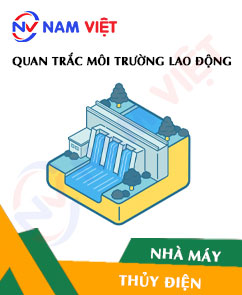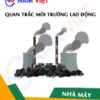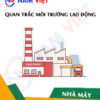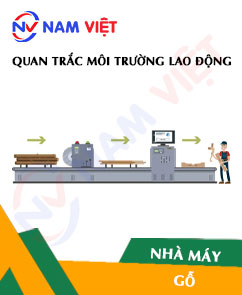Occupational Environment Monitoring at a Hydropower Factory
99,000 ₫
Note: The above price is calculated per sample and may vary depending on the area of the environment to be monitored and market fluctuations. For more accurate pricing support, please refer to the price list or contact our consulting staff directly.
Monitoring the environment of a hydroelectric power factory is a session for collecting, analyzing, and evaluating workplace factors that may be harmful to workers’ health.
Table of Contents
Toggle1. Overview of Hydropower Factories
a. What is a Hydropower Factory?
Factory hydropower is a type of power factory built on rivers, streams, or large reservoirs to harness the energy of flowing water to generate electricity. Hydropower technology uses the principle of converting the energy from flowing water into electrical energy.
The basic structure of a hydropower factory includes:
- Dam: The dam is constructed to create a large reservoir. When water is retained by the dam, the water pressure generates a force as it flows through gaps or pipelines to produce energy.
- Fluid system: Water from the reservoir is converted into kinetic energy by passing through pipelines or channels to create pressure and thrust. Flowing water passes through equipment such as turbines, water wheels, or nozzles to generate mechanical energy.
- Turbine: The turbine is the main device in a hydropower factory, converting mechanical energy from flowing water into rotational energy. Turbines are usually coupled with generators to produce electricity.
- Generator: The generator receives energy from the turbine and converts it into electrical energy. Electricity is produced using capacitors and transmission systems.
Hydropower factories have many advantages, including the use of renewable energy, no harmful emissions or greenhouse gases, and contribution to environmental protection. However, constructing a hydropower factory requires significant capital investment and may affect the natural environment and local ecology.

b. Production processes in a hydropower factory
The production processes in a hydropower factory include the following key steps:
- Dam construction: The first step is building a dam to create a large reservoir. The dam is designed to retain water and create a height difference to harness the energy of flowing water.
- Water conveyance system: Water from the reservoir is directed through pipelines or channels to the hydropower factory. This system includes components such as pipes, valves, filters, and flow control systems.
- Hydropower factory: Water from the conveyance system enters the hydropower factory. Inside the factory, water acts on the turbine to generate mechanical energy. The turbine converts the energy of flowing water into rotational energy.
- Generator: Rotational energy from the turbine is transmitted to the generator. The generator uses an electromagnetic structure and magnets to convert mechanical energy into electrical energy. The electricity is produced and fed into the grid for use.
- Control and monitoring: Control and monitoring systems are used to manage and adjust the electricity production process. Parameters such as water flow, pressure, and turbine rotation speed are monitored and adjusted to ensure efficiency and operational safety.
- Protection and safety systems: Protection and safety systems are installed to monitor and safeguard equipment and facilities within the hydropower factory. This includes overload protection, fire alarm systems, overvoltage protection, and other safety measures.
- Maintenance and repair: Maintenance and repair are carried out periodically to ensure effective operation and reliability of the hydropower factory. These activities include inspections, cleaning, lubrication, component replacement, and repairing malfunctions.

c. Hydropower factories in Vietnam
In Vietnam, many hydropower factories have been built on rivers and reservoirs. Some notable hydropower factories include:
- Son La Hydropower Factory: Built on the Da River in Son La Province, it is the largest hydropower factory in Vietnam with a capacity of 2,400 MW. Completed in 2012.
- Hoa Binh Hydropower Factory: Located on the Da River in Hoa Binh Province, with a capacity of 1,920 MW. It is one of the largest and most important hydropower factories in Vietnam, operating since 1988.
- Se San 3 Hydropower Factory: Built on the Se San River in Gia Lai Province, with a capacity of 260 MW. Operational since 2010.
- Da Nhim Hydropower Factory: Located on the Da Nhim River in Lam Dong Province, with a capacity of 160 MW. Operational since 1964.
- Yaly Hydropower Factory: Built on the Se San River in Kon Tum Province, with a capacity of 720 MW. Operational since 2001.
Besides these, Vietnam has many other hydropower projects under construction and development to exploit the country’s hydropower potential.

d. Occupational diseases in hydropower factory workers
Working in a hydropower factory exposes workers to various risks and factors causing occupational diseases. Common occupational diseases include:
- Respiratory diseases: Workers may be exposed to dust and toxic fumes from construction, maintenance, or operations. This can lead to asthma, bronchitis, pneumonia, and other respiratory issues.
- Skin diseases: Contact with chemicals, oils, or water can cause skin irritation, dermatitis, eczema, and other skin problems.
- Accidents: Workplace accidents can occur during construction, maintenance, or operation. Risks include impact injuries, falls, drowning, and other accidents causing serious injuries or fatalities.
- Musculoskeletal disorders: Workers often perform heavy physical tasks. Lifting, working in difficult conditions can cause injuries, back pain, cervical spine degeneration, and other musculoskeletal issues.
- Stress and psychological disorders: Working in a hydropower factory may involve high pressure, dangerous conditions, and high concentration, potentially causing stress, anxiety, and other mental health issues.
To protect workers’ health, safety measures, personal protective equipment, training, and monitoring are essential. Regular health checks and care are also important to detect and treat occupational health issues early.

2. Overview of Occupational Environmental Monitoring Services
a. What is occupational environmental monitoring in hydropower factories?
Occupational environmental monitoring (or workplace environmental measurement) in hydropower factories is the activity of collecting, evaluating, and analyzing measured indicators of environmental factors in the factory. This is done to implement timely measures, minimize environmental hazards to workers’ health, and prevent occupational diseases. Occupational environmental monitoring is mandatory for hydropower factories.
Monitoring plays a crucial role in protecting and promoting workers’ health because workers are the main resource of the enterprise and directly generate profits. Workers who are frequently exposed to hazards exceeding allowable limits can experience health issues and occupational diseases.
REGISTER FOR OCCUPATIONAL ENVIRONMENTAL MONITORING SERVICE
b. Nam Viet’s occupational environmental monitoring program
Nam Viet’s occupational environmental monitoring program was developed by monitoring engineers specializing in occupational safety and environmental protection. With the goal of ensuring health and safety for workers, this program uses modern measurement methods to monitor air quality, water quality, and microclimate, physical, and dust factors in the workplace. This program is essential to ensure a safe working environment and protect workers’ health.
Additionally, Nam Viet’s program plays a significant role in researching and developing new solutions to improve workplace environmental quality. With the dedication and professionalism of monitoring experts, Nam Viet’s exclusive monitoring program is becoming a breakthrough in occupational safety and environmental management in Vietnam.

c. Standardization in workplace environmental measurement procedures
Standardization in Nam Viet’s workplace environmental measurement procedures is crucial to ensure measurement accuracy. To guarantee reliability, the program follows standards and standardized procedures recognized by the Ho Chi Minh City Department of Health. This ensures that collected data can be reliably used for evaluating the factory environment and making decisions to improve workplace conditions for workers’ health.
These standardized procedures also ensure that measurements are conducted by highly qualified monitoring specialists with years of experience, allowing managers and experts to trust Nam Viet’s results and make accurate, valuable decisions for protecting workers and the environment.
By applying standardized measurement procedures, Nam Viet demonstrates its commitment to ensuring a safe working environment, protecting workers’ health, and contributing to improving occupational safety and environmental management in Vietnam.
d. Reporting results of occupational environmental monitoring in hydropower factories
Monitoring results are prepared according to Form No. 04, Appendix III issued with Decree 44/2016/ND-CP and prepared in two copies: one sent to the factory where the monitoring service contract is signed, and one retained by the monitoring organization.
The retention period for occupational environmental monitoring results is unlimited as regulated by law.

e. Frequency of occupational environmental monitoring as required by law
According to Clause 2, Article 18, Labor Safety and Hygiene Law 84/2015/QH13, employers must organize occupational environmental monitoring to assess harmful factors at least once a year.
f. Deadline for submitting occupational environmental monitoring reports according to law
The deadline for submission is before December 31 each year. Enterprises of production facilities must submit the monitoring results report to the local Department of Health where the enterprise is headquartered and where employees work.
When there are changes in technology, production processes, or upgrades that may generate new hazards, enterprises must update occupational hygiene records concerning harmful factors requiring monitoring.
g. Penalties for violations of occupational environmental monitoring regulations by employers
According to Article 27 of Decree No. 12/2022/ND-CP dated January 17, 2022, regulating administrative penalties in labor, social insurance, and overseas Vietnamese labor contracts:
- Clause 2: A fine of 2,000,000 – 5,000,000 VND for employers who do not publicly disclose monitoring results to workers at the monitoring site and locations under hazard control immediately after receiving monitoring and assessment results.
- Clause 3: A fine of 20,000,000 – 40,000,000 VND for employers who fail to conduct occupational environmental monitoring to control health hazards as required by law.
- Clause 4: A fine of 40,000,000 – 60,000,000 VND for employers colluding with monitoring organizations to commit fraud in environmental monitoring activities, without reaching the level of criminal liability.
3. Harmful environmental factors for workers in hydropower factories
Workers in hydropower factories may be exposed to the following harmful environmental factors:
- Toxic fumes: During construction, maintenance, or operation of hydropower factories, there may be chemicals and toxic gases such as welding fumes, oil fumes, gasoline vapors, plasma cutting fumes, and other toxic gases. Exposure to these substances in unsafe environments can cause damage to the respiratory system, nervous system, and other health problems.
- Dust and fine particles: During construction, cutting, grinding, and maintenance of materials, dust and fine particles may be generated in the air. Long-term exposure to dust and particles can cause respiratory irritation, pneumonia, occupational lung diseases, and other health issues.
- Noise: Activities in hydropower factories such as turbines, generators, and other equipment may produce high levels of noise. Exposure to high noise levels for long periods can cause hearing damage, accidents, and negative effects on overall health.
- Temperature and humidity: In some hydropower factories, especially in indoor working areas, temperature and humidity can fluctuate and be uncomfortable. Extremely hot or cold working conditions can cause fatigue, lack of concentration, and affect health and work performance.
- Height and harsh working conditions: Hydropower factories are often built on high terrain, mountainous areas, or hard-to-reach locations. Working under such external conditions, including height, harsh weather, and difficult environments, poses risks and requires caution for workers.
4. Measures to improve the working environment in hydropower factories
To improve the working environment in hydropower factories and protect workers’ health, the following measures can be applied:
- Implement safe work procedures: Ensure that hydropower factories comply with all labor safety regulations and procedures. This includes defining safety rules, safe access and work procedures, and training all staff on safety and emergency response.
- Provide personal protective equipment: Ensure workers are fully equipped with appropriate personal protective equipment such as helmets, safety glasses, masks, gloves, safety shoes, reflective vests, and other protective gear. Also, ensure proper usage and maintenance of this equipment.
- Risk assessment and control: Conduct assessments to identify harmful environmental factors in hydropower factories. Apply control measures such as dust extraction systems, safe work procedures, environmental monitoring, and ensure safe handling and disposal of waste.
- Training and awareness: Ensure that all staff in hydropower factories are trained on occupational safety, safe work procedures, and awareness of the risks and impacts of unsafe working environments. Enhance educational programs and safety and health awareness among workers.
- Environmental impact management: Apply environmental management measures to reduce negative impacts on the environment during construction, operation, and maintenance of hydropower factories. This includes waste management, water management, air pollution control, and protection of natural resources.
- Periodic medical check-ups: Conduct regular medical examinations for workers to detect and treat health problems related to working in hydropower factories at an early stage.
- Periodically organize occupational environmental monitoring in factories, collect and analyze harmful factors for workers, and adjust to reduce hazards to prevent occupational diseases.
5. Benefits of regular monitoring in hydropower factories
An Toan Nam Viet provides businesses with excellent advantages when using occupational environmental monitoring services according to Decree 44/2016/ND-CP on the management and control of harmful factors in the working environment affecting workers.
- Businesses can proactively control harmful factors in workshops or factories.
- Receive advice and recommendations on measures to reduce harmful factors and improve the quality of the working environment.
- Indirectly protect human resources, the key factor in business development.
- Reduce the impact of occupational diseases on human health, thereby reducing future treatment costs.
- Improved worker health leads to better product quality and production output.
- Comply with labor safety laws, avoiding legal risks.
- Create credibility and professionalism in all aspects, enhancing the company’s brand.
Nam Viet’s environmental monitoring service is a solution to reduce the impact of occupational diseases, contributing to a clean and quality working environment.

REGISTER FOR OCCUPATIONAL ENVIRONMENTAL MONITORING SERVICE
6. National Occupational Environmental Monitoring Center
Occupational Environmental Monitoring Center of Nam Viet is a professional unit specializing in monitoring and measuring the quality of the working environment across all provinces in Vietnam. With a team of experienced monitoring specialists, the center uses modern measurement equipment to ensure accuracy and reliability.
Besides providing monitoring services, the center also assists customers in planning, handling, and tracking occupational environmental issues. With the motto “customer-centered,” the center prioritizes customer satisfaction, meets all customer needs, and commits to providing the best solutions for businesses.
REGISTER FOR OCCUPATIONAL ENVIRONMENTAL MONITORING SERVICE
With investment in technology, equipment, and human resources, Nam Viet’s monitoring center has become one of the most reputable units in occupational environmental monitoring in Ho Chi Minh City with the following objectives:
- We always value brand reputation and the quality of our services.
- We provide customers with the best and most suitable solutions.
- With a team of experienced Masters and Engineers committed to environmental protection and business benefits.
- By joining Nam Viet Environmental Monitoring team, your company will receive professional service from experts in the field of monitoring, along with the best cost advantages.
The occupational environmental monitoring process at Nam Viet includes the following basic steps:
- Before performing monitoring, we ensure all machines and equipment for occupational environmental monitoring are calibrated according to legal regulations.
- Perform the monitoring process in full compliance with the procedure committed to the Department of Health.
- Report occupational environmental monitoring results honestly to the employer.
- If monitoring results show unsafe conditions for workers, Nam Viet will provide solutions, and the enterprise will implement as follows:
- Implement measures to improve working conditions to minimize the impact of harmful factors and prevent occupational diseases.
- Organize health check-ups to detect occupational and work-related diseases early for employees in unsafe working environments.
- Provide material compensation to employees according to labor law regulations.

7. Occupational Environmental Monitoring Pricing
To help businesses perform occupational environmental monitoring professionally and effectively, Nam Viet provides customers with a pricing table for occupational environmental monitoring services that is high-quality and reasonably priced.
- Our pricing table provides detailed information on the costs of the monitoring services we offer, including costs related to travel, measurement, analysis, and reporting. Customers can be assured of the accuracy and reliability of the monitoring results we provide.
- We commit to providing competitive and reasonable prices in the market and are always ready to answer any questions about monitoring services quickly and professionally.
- With Nam Viet’s pricing table, customers can easily choose service packages suitable for their needs. We are committed to providing the highest customer satisfaction with professional service quality.
No comments yet












Review Occupational Environment Monitoring at a Hydropower Factory
There are no reviews yet.